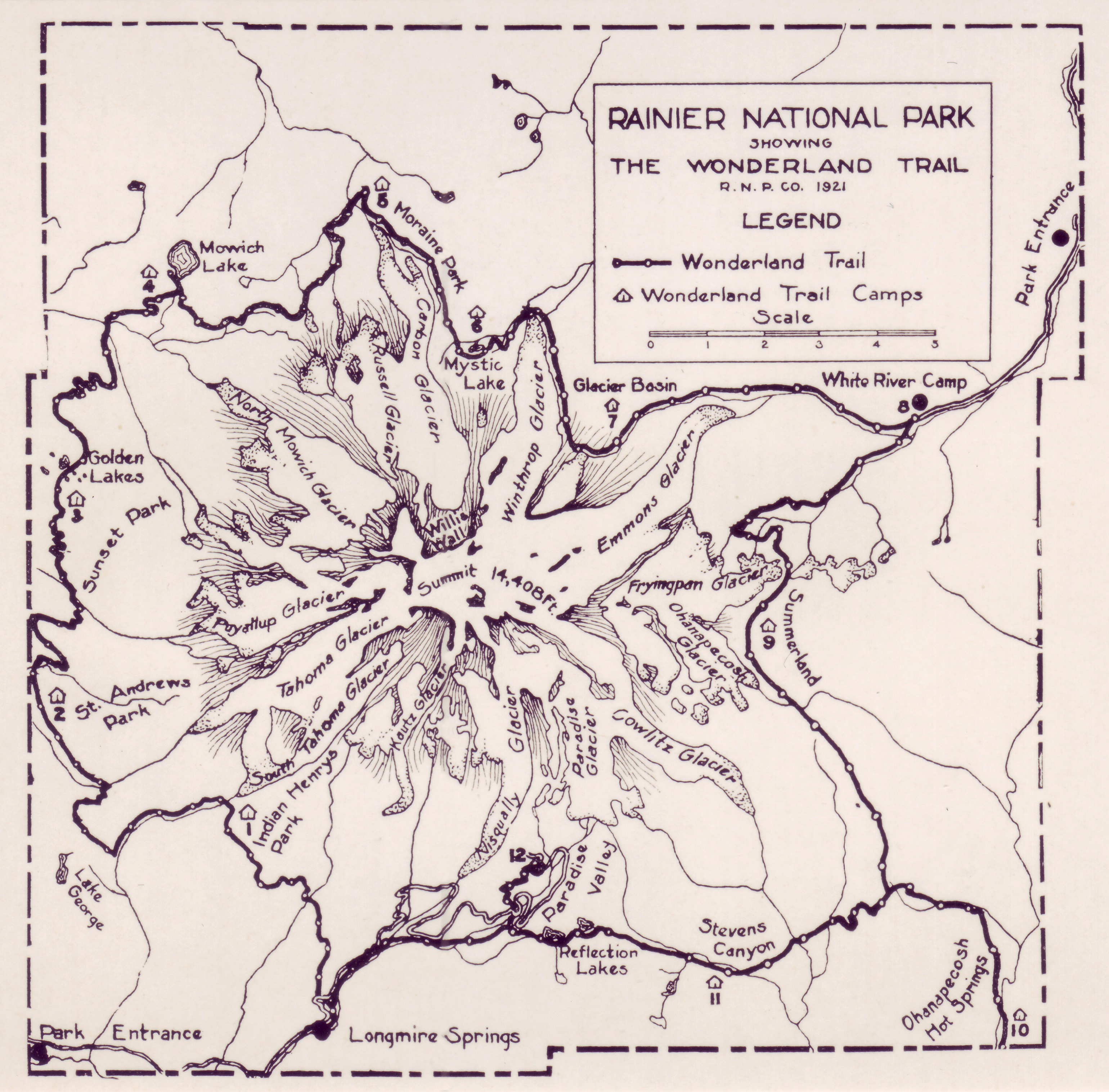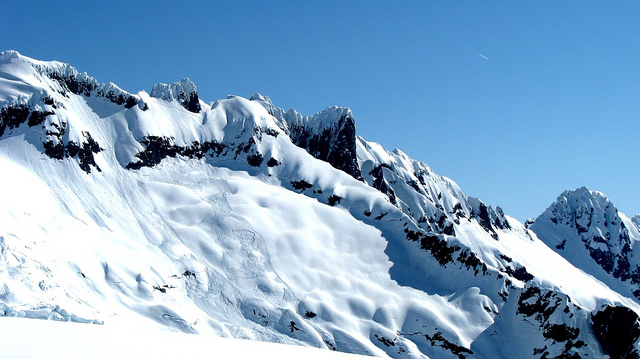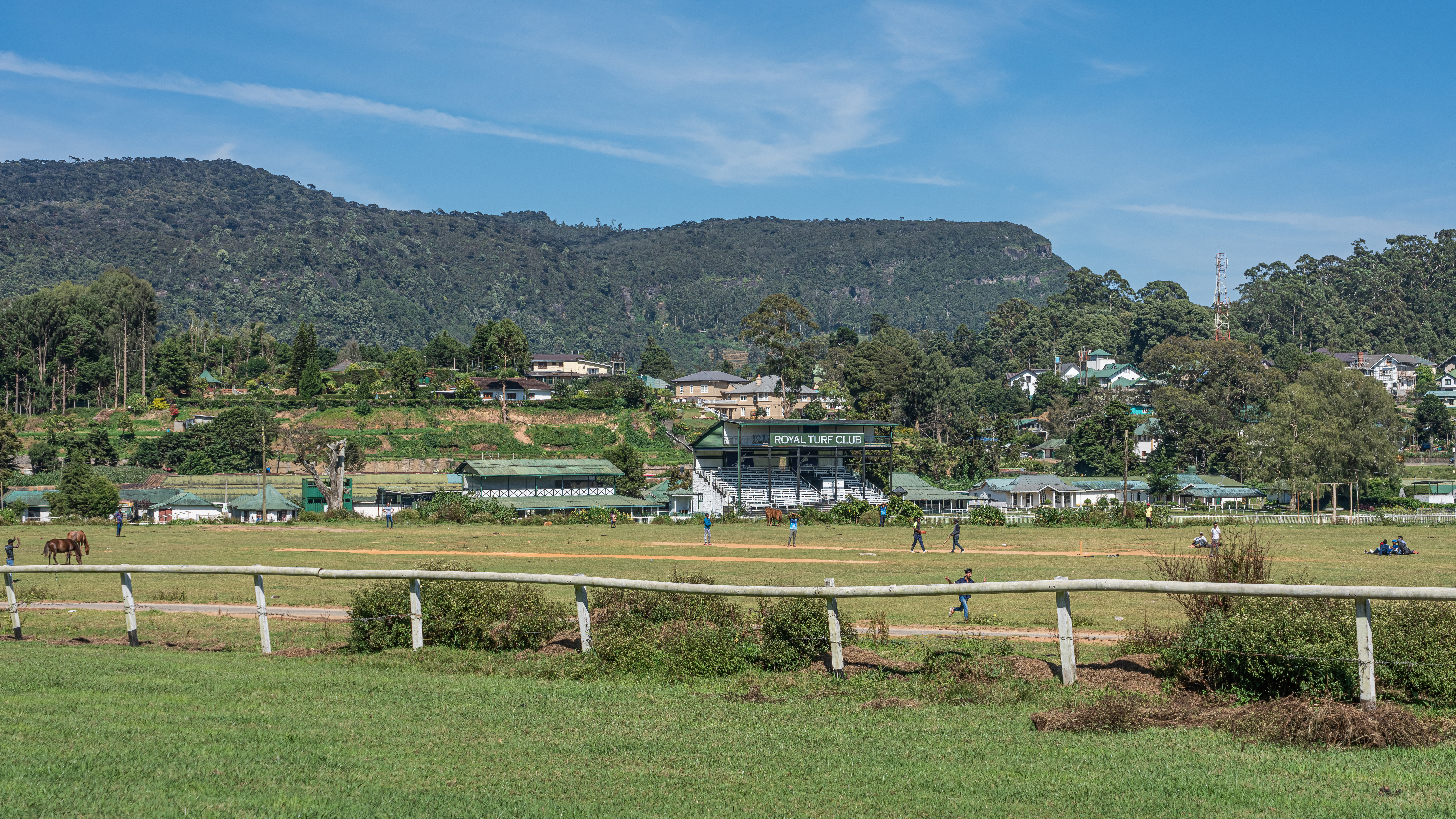|
Crescent Mountain (Washington)
Crescent Mountain, a ridge-like peak standing at 6,715 ft (2,047 m), is located in north-central Mount Rainier National Park, in Pierce County of Washington state. It is part of the Cascade Range, and lies due north of the summit of Mount Rainier. Sluiskin Mountain is its nearest higher neighbor, to the east. Precipitation runoff from Crescent Mountain drains west into tributaries of the Carbon River. History The mountain's descriptive name, Crescent, originates from its crescent shape as it envelops Crescent Lake. Geologist Bailey Willis named this feature in 1883.Mount Rainier National Park Place Names. Gary Fuller Reese (author), 2009. The name was officially adopted in 1932 by the United States Board on Geographic Names. Climate Crescent Mountain lies within the marine west coast climate zone of western North America.Beckey, Fred W. Cascade Alpine Guide, Climbing and High Routes. Seattle, WA: Mountaineers Books, 2008. Most weather fronts originating in the Pacific ... [...More Info...] [...Related Items...] OR: [Wikipedia] [Google] [Baidu] |
Old Desolate
Old Desolate is a multi-summit, ridge-like mountain located in Mount Rainier National Park, in Pierce County, Washington, Pierce County of Washington (U.S. state), Washington state. It is part of the Cascade Range, and lies due north of the summit of Mount Rainier. The Wonderland Trail provides an approach to this mountain, and the summit offers views of Sluiskin Mountain and Mount Rainier. Burroughs Mountain is the nearest higher neighbor, to the southeast. Precipitation Surface runoff, runoff from Old Desolate drains east into the West Fork White River (Washington), White River, or west into the Carbon River. History The descriptive name ''Old Desolate'' derives from its position standing desolate and alone at the western edge of Vernal Park.Mount Rainier National Park Place Names. Gary Fuller Reese (author), 2009. The toponym was officially adopted in 1932 by the United States Board on Geographic Names, which noted that there were three peaks on the mountain, with elevat ... [...More Info...] [...Related Items...] OR: [Wikipedia] [Google] [Baidu] |
Marine West Coast
An oceanic climate, also known as a marine climate or maritime climate, is the temperate climate sub-type in Köppen classification represented as ''Cfb'', typical of west coasts in higher middle latitudes of continents, generally featuring cool to warm summers and cool to mild winters (for their latitude), with a relatively narrow annual temperature range and few extremes of temperature. Oceanic climates can be found in both hemispheres generally between 40 and 60 degrees latitude, with subpolar versions extending to 70 degrees latitude in some coastal areas. Other varieties of climates usually classified together with these include subtropical highland climates, represented as ''Cwb'' or ''Cfb'', and subpolar oceanic or cold subtropical highland climates, represented as ''Cfc'' or ''Cwc''. Subtropical highland climates occur in some mountainous parts of the subtropics or tropics, some of which have monsoon influence, while their cold variants and subpolar oceanic climates occu ... [...More Info...] [...Related Items...] OR: [Wikipedia] [Google] [Baidu] |
Mountains Of Pierce County, Washington
A mountain is an elevated portion of the Earth's crust, generally with steep sides that show significant exposed bedrock. Although definitions vary, a mountain may differ from a plateau in having a limited summit area, and is usually higher than a hill, typically rising at least above the surrounding land. A few mountains are inselberg, isolated summits, but most occur in mountain ranges. mountain formation, Mountains are formed through tectonic plate, tectonic forces, erosion, or volcanism, which act on time scales of up to tens of millions of years. Once mountain building ceases, mountains are slowly leveled through the action of weathering, through Slump (geology), slumping and other forms of mass wasting, as well as through erosion by rivers and glaciers. High elevations on mountains produce Alpine climate, colder climates than at sea level at similar latitude. These colder climates strongly affect the Montane ecosystems, ecosystems of mountains: different elevations hav ... [...More Info...] [...Related Items...] OR: [Wikipedia] [Google] [Baidu] |
Mother Mountain (Washington)
Mother Mountain is a multi-summit, 3-mile long ridge-like mountain located in Mount Rainier National Park, in Pierce County of Washington state. It is part of the Cascade Range, and lies northwest of the summit of Mount Rainier. The Wonderland Trail provides one approach option to this mountain, and the summit offers views of Mount Rainier. East Fay Peak is its nearest higher neighbor, to the south. Precipitation runoff from Mother Mountain is drained by Cataract Creek on the south side of the mountain, and Ipsut Creek drains the north side of it, and both are tributaries of the Carbon River. The west side drains into Mowich Lake, and thence Mowich River. History The name ''Mother Mountain'' derives from the figure of a woman which can be seen silhouetted along the northeast summit of the ridge.Mount Rainier National Park Place Names. Gary Fuller Reese (author), 2009. The toponym was officially adopted in 1913 by the United States Board on Geographic Names. The first ... [...More Info...] [...Related Items...] OR: [Wikipedia] [Google] [Baidu] |
Wonderland Trail
The Wonderland Trail is an approximately hiking trail that circumnavigates Mount Rainier in Mount Rainier National Park, Washington, United States. The trail goes over many ridges of Mount Rainier for a cumulative of elevation gain. The trail was built in 1915. In 1981, it was designated a National Recreation Trail. An estimated 200 to 250 people a year complete the entire trail with several thousand others doing shorter sections of it. The average time taken to complete the entire trip is 10 to 14 days. Route The trail is entirely within the national park and passes through major life zones of the park, from lowland forests to subalpine meadows of wildflowers. As the trail circles the mountain, hikers see different faces of Mount Rainier, carved by 25 named glaciers. The trail is considered strenuous as it is almost always climbing or descending the ridges around the mountain. The highest point is at Panhandle Gap. There are many river crossings on the trail includi ... [...More Info...] [...Related Items...] OR: [Wikipedia] [Google] [Baidu] |
Carbon Glacier
Carbon Glacier is located on the north slope of Mount Rainier in the U.S. state of Washington and is the source of the Carbon River. The snout at the glacier terminal moraine is at about above sea level, making it the lowest-elevation glacier in the contiguous United States. The glacier also has the greatest length (), thickness () and volume () of any U.S. glacier outside of Alaska. At over a mile wide, the Carbon Glacier cirque is the largest in the Cascade Mountains. The headwall of the cirque is the prominent Willis Wall landform. Carbon Glacier is accessible from the northwest Carbon River entrance of Mount Rainier National Park, just outside the town of Carbonado, Washington. The glacier is accessible on foot via an hike from the Carbon River entrance of Mt. Rainier National Park. The road and trail is currently washed out in several areas due to flooding of the Carbon River in 2006. See also *List of glaciers in the United States Glaciers are located in ten states ... [...More Info...] [...Related Items...] OR: [Wikipedia] [Google] [Baidu] |
Skyscraper Mountain
Skyscraper Mountain is a summit in Pierce County of Washington state. Description Skyscraper Mountain is part of the Cascade Range and is located in Mount Rainier National Park. It is situated northwest of the Sunrise Historic District, from which a four-mile hike leads to the mountain, mostly on the Wonderland Trail. However, the trail does not reach the summit, but it is still a walk up to the top from Skyscraper Pass. The summit provides views of Burroughs Mountain, Sluiskin Mountain, and Mount Rainier. Access is limited by snowpack closing the Sunrise Road much of the year. July, August, and September are typically the months when the Sunrise Road is seasonally open for vehicle traffic. Precipitation runoff from Skyscraper Mountain drains into tributaries of the White River and topographic relief is significant as the summit rises above the river in one mile (1.6 km). Mount Fremont is the nearest higher peak, to the east. History The descriptive name ''Skyscr ... [...More Info...] [...Related Items...] OR: [Wikipedia] [Google] [Baidu] |
Geology Of The Pacific Northwest
The geology of the Pacific Northwest includes the composition (including rock, minerals, and soils), structure, physical properties and the processes that shape the Pacific Northwest region of North America. The region is part of the Ring of Fire: the subduction of the Pacific and Farallon Plates under the North American Plate is responsible for many of the area's scenic features as well as some of its hazards, such as volcanoes, earthquakes, and landslides. The geology of the Pacific Northwest is vast and complex. Most of the region began forming about 200 million years ago as the North American Plate started to drift westward during the rifting of Pangaea. Since that date, the western edge of North America has grown westward as a succession of island arcs and assorted ocean-floor rocks have been added along the continental margin. There are at least five geologic provinces in the area: the Cascade Volcanoes, the Columbia Plateau, the North Cascades, the Coast Mountains, an ... [...More Info...] [...Related Items...] OR: [Wikipedia] [Google] [Baidu] |
Avalanche
An avalanche is a rapid flow of snow down a Grade (slope), slope, such as a hill or mountain. Avalanches can be triggered spontaneously, by factors such as increased precipitation or snowpack weakening, or by external means such as humans, other animals, and earthquakes. Primarily composed of flowing snow and air, large avalanches have the capability to capture and move ice, rocks, and trees. Avalanches occur in two general forms, or combinations thereof: slab avalanches made of tightly packed snow, triggered by a collapse of an underlying weak snow layer, and loose snow avalanches made of looser snow. After being set off, avalanches usually accelerate rapidly and grow in mass and volume as they capture more snow. If an avalanche moves fast enough, some of the snow may mix with the air, forming a powder snow avalanche. Though they appear to share similarities, avalanches are distinct from slush flows, Mudflow, mudslides, Landslide#Debris landslide, rock slides, and serac collap ... [...More Info...] [...Related Items...] OR: [Wikipedia] [Google] [Baidu] |
Oceanic Climate
An oceanic climate, also known as a marine climate or maritime climate, is the temperate climate sub-type in Köppen climate classification, Köppen classification represented as ''Cfb'', typical of west coasts in higher middle latitudes of continents, generally featuring cool to warm summers and cool to mild winters (for their latitude), with a relatively narrow annual temperature range and few extremes of temperature. Oceanic climates can be found in both hemispheres generally between 40 and 60 degrees latitude, with subpolar versions extending to 70 degrees latitude in some coastal areas. Other varieties of climates usually classified together with these include subtropical highland climates, represented as ''Cwb'' or ''Cfb'', and subpolar oceanic or cold subtropical highland climates, represented as ''Cfc'' or ''Cwc''. Subtropical highland climates occur in some mountainous parts of the subtropics or tropics, some of which have monsoon influence, while their cold variants an ... [...More Info...] [...Related Items...] OR: [Wikipedia] [Google] [Baidu] |
Orographic Lift
Orographic lift occurs when an air mass is forced from a low elevation to a higher elevation as it moves over rising terrain. As the air mass gains altitude it quickly cools down adiabatically, which can raise the relative humidity to 100% and create clouds and, under the right conditions, precipitation. Orographic lifting can have a number of effects, including precipitation, rain shadowing, leeward winds, and associated clouds. Precipitation Precipitation induced by orographic lift occurs in many places throughout the world. Examples include: * The Mogollon Rim in central Arizona * The western slope of the Sierra Nevada range in California. * The western slope of the Wasatch Range in Utah. Specifically the Little and Big Cottonwood Canyons. * The mountains near Baja California North – specifically La Bocana to Laguna Hanson. * The windward slopes of Khasi and Jayantia Hills (see Mawsynram) in the state of Meghalaya in India. * The Western Highlands of Yemen, which rece ... [...More Info...] [...Related Items...] OR: [Wikipedia] [Google] [Baidu] |
Cascade Mountains
The Cascade Range or Cascades is a major mountain range of western North America, extending from southern British Columbia through Washington and Oregon to Northern California. It includes both non-volcanic mountains, such as many of those in the North Cascades, and the notable volcanoes known as the High Cascades. The small part of the range in British Columbia is referred to as the Canadian Cascades or, locally, as the Cascade Mountains. The highest peak in the range is Mount Rainier in Washington at . part of the Pacific Ocean's Ring of Fire, the ring of volcanoes and associated mountains around the Pacific Ocean. All of the eruptions in the contiguous United States over the last 200 years have been from the Cascade Volcanoes. The two most recent were Lassen Peak from 1914 to 1921 and a major eruption of Mount St. Helens in 1980. Minor eruptions of Mount St. Helens have also occurred since, most recently from 2004 to 2008. The Cascade Range is a part of the American Cordil ... [...More Info...] [...Related Items...] OR: [Wikipedia] [Google] [Baidu] |






